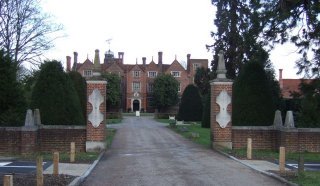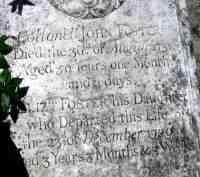
Ancestry of Joseph Foster (-Barham) (*1729)
| Page AS VI.51 to overview | |||||||||||||||||||
|
|
|
| ||||||||||||||||
|
| ||||||||||||||||||
| |||||||||||||||||||
Joseph Foster (later Foster-Barham) 1754 x Dorothea Vaughan |
|||||||||||||||||||

|
Thomas Fo(r)ster and NN
Thomas was Judge of the High Court.
The couple had 4 children, among them Thomas.
Sir Thomas followed his father as owner of "Great Fosters"
(see picture) in Egham, Surrey.
The information about Great Fosters from
(Wikipedia)
is given here in slightly adjusted form.
Great Fosters is currently a hotel.
Great Fosters is a 16th century mansion which originally lay within
Windsor Great Park adjacent to the town of Egham, Surrey, England.
It was the London seat of Sir John Dodderidge (1555-1628),
a Judge of the King's Bench and formerly Solicitor General to King
James I. He had been brought up in Barnstaple, in North Devon, and
purchased the estate of Bremridge near South Molton, Devon, as his
country estate. His epitaph on his monument in Exeter Cathedral states
"He departed this lyfe at Forsters nere Egha(m) in Surrey".
Sir Robert Foster owned the house in 1639.
When he died in 1663 he left the house to his son, Sir Thomas
Foster.
Following his death in 1685 Great Fosters passed to his daughters. In 1715, Sir Charles Orby
resided here, and it was not until 1787 that one of Sir Thomas' great
grandsons sold the property to a Mr Wyatt for £700.
In about 1550, the original house was built as a symmetrical U-shaped Elizabethan homestead. It is probable that it was extended in the early 17th century because there is slightly larger brickwork in the porch. It was at this time the initial tall chimneys were built. However, these pinnacles were removed during World War II after a bomb blast. They have been replaced by replicas.
A dominant feature of the house is the windows, all of which are stone mullions and transoms with leaded lights.
Son Thomas Foster took interest in investment in Jamaica.
Thomas and Mary
Thomas was Colonel.
He likely served in the British navy when Jamaica was conquered from
the Spanish in 1655.
He obtained large tracts of land on the island.
The family lived at Elim, St Elizabeth Parish, Jamaica.
Elim is at the eastern edge of the St Elizabeth Parish.
Children on Jamaica:
Thomas, 1681 John, William, 1691 Rachel, Mary.
Information adapted from
genforum barham messages:
Colonel Thomas Foster was reputed to have served as an officer under Penn and Venables in the 1655 expedition (see box above).
Certainly he established himself at Elim in the parish of
St. Elizabeth, Jamaica. His son, Colonel John Foster, married
Elizabeth Smith (see below), by whom he had a large family.
Joseph Foster of Hardwick Hall, Shropshire (father of the MP
for Stockbridge), was a son of this marriage.

John Foster and Elizabeth
John was born at the plantation of his parents at Elim, St Elisabeth Parish.
Elizabeth is said to have been born in Barbados,
the centre of english presence in the Caribbean at that time.
The couple lived at their sugar plantation on Jamaica.
John held the military rank of Colonel.
Children: ~1713 Mary, 1720 Thomas, 1722 William, 1723 John,
1725 Samuel, 1726 Elizabeth(+1729), 1727 Sarah, 1728 Margaret,
1729 Joseph (later Foster-Barham), Hester.
John died in 1731 at Elim and was buried at Montego Bay
(see photo of
gravestone; his daughter Elizabeth had died two years previous).
Montego Bay is at the north side of the island and just south of town
is the Bogue Hill (see below at "Moravians").
Elizabeth remarried with Henry Barham, owner of a neighbouring plantation. Henry's father had become surgeon and worked in the military forces on Jamaica. He returned to England but came back to Jamaica for an investment in a silver mine. He died in 1726. Son Henry Barham, also doctor of medicine, acquired a plantation, next to the one of the Fosters.

|
In the late 1730's Henry and Elizabeth moved to England and settled in Staines, Middlesex. Henry died there in 1746, Elizabeth in 1756. Their memorial inscription on the north wall of north gallery (from Legacies British Slave-ownership) reads:
| Here lie the remains of Henry Barham, Esqr. who was descended from Nicholas Barham of Kent, sergeant at law (vide Warburtons Midx.) and who died at Duncroft House, in this parish 1746 abt. 51 years. Also of Elizabeth his wife, who died 1756 abt. 55 years: she was the widow of John Foster, Esq whose ancestor Captn. Thomas Foster, of Northumberland being concerned in the capture of Jamaica, had large grants of land allotted him in that island: by her first husband, she had issue Thomas, John, William, Samuel, and Joseph; also two daughters, Margaret and Sarah. Thomas was sometime M.P. for Dorchester, he died without issue and is buried here. John also died without issue. William and Samuel: both had issue whose families still survive. Margaret married Colin Campbell Esqr. whose son Colin was Colonel in the Guards, and dying without issue is buried [here?]. Sarah married William Mathew Burt Esqr. who was M.P. for Great Marlow, and subsequently Governor General of the Leeward Islands where he died. Joseph the youngest son of his wife, Henry Barham who, dying without issue, bequeathed his estate on condition of his taking the name of Barham. Joseph married Dorothy the daughter of John Vaughan, Esq. of Trecoon, Pembrokeshire; and in 2nd marriage, the Lady Hill, of Hardwick Hall, Shropshire; where they both lie buried. |
John Foster and Elizabeth were religious and sympathetic to the Moravian church. Son Joseph helped the Moravians to become active on Jamaica.
From "The Moravians in Jamaica" (1854):
In the parish of St. Elizabeth on Jamaica are situated several
sugar estates, Elim, Lancaster, Two-mile-wood, and the Bogue, the
property of the Foster and Barham families, names well known in
our church and mission. A hundred years ago, the proprietors of
these plantations applied to the United Brethren for missionaries to
preach the gospel to their slaves. The Brethren, ever ready to
listen to such an application, complied with their request, and on
the seventh of December, 1754, the Brethren Zecharias Caries, Thomas
Shallcross, and Gotlieb Haberecht arrived in Jamaica. The Bogue
Estate, on which the Brethren were located, and the other estates
above named, are situated in a most unhealthy locality at the foot of
the Manchester mountains, too far inland to admit the burning and
intolerable heat to be mitigated by the sea-breeze. The land is very
rich and productive, the sugar-cane thrives remarkably well, and the
Black river, navigable for large boats, offers every accommodation for
shipping. Altogether, this part of the country possesses so many
advantages, that we need not be surprised to hear, that no fewer than
nine hundred slaves belonged to these plantations; and that the
produce of their labour was a rich mine of wealth.
(Text taken from Buchner 1854).
The Fosters were presented with a plaque from the Moravian church in
recognition of their bringing the mission to Jamaica. The family still
had the plaque in their possession when they owned the Chatham Hotel,
one of the first hotels in Montego Bay (Buchner 1854).
|
The "Moravians" (re-)established themselves in the 18th century as a protestant pietistic religious group, having originated in Bohemia and Moravia. At a special Communion service in Herrnhut in Saxony on August 13, 1727, a lasting evangelical zeal was created (and it later made Herrnhut the centre of a worldwide Christian outreach program). As of the 1730's, the "Moravians" went into the world to spread their (protestant and pietistic) beliefs. The first foreign missionaries ("diaspora Moravians") left Herrnhut in 1732 to begin their work among black slaves in the West Indies (adapted from Encycl. Brittanica). |
Data from Genealogy
Foster-Barham and further sources as indicated.
Buchner, J.H., 1854, "The Moravians in Jamaica"
Gibson, C., 2014, "Empires Crossroads - A history of the
Caribbean from Columbus to the present day"; Macmillan
Mann, C. C., 2011, "1493 - How Europe's discovery of the Americas
Revolutionized Trade, Ecology and Life on Earth"; Granta Publ.
Robson, T., 1830, "The British Herald; Or, Cabinet of Armorial
Bearings of the Nobility & Gentry of Great Britain & Ireland"
Tortelo, R., 2015, on
Jamaica Gleaner - story 0059
Wikipedia: History of Jamaica.
(2017.03.19) created Feb. 2012